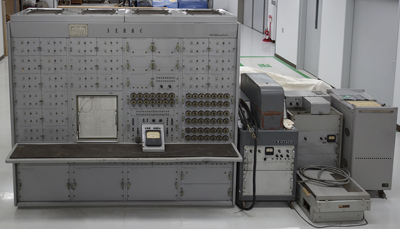

- Home >
- Artifacts of IP Heritage >
- 2013 >
- Strong Earthquake Response Analysis Computer (SERAC)
Strong Earthquake Response Analysis Computer (SERAC)

| Manufactured in | 1961 |
|---|---|
| Manufactured by | Hitachi Ltd. |
| Owner | The National Museum of Nature and Science, Tokyo |
| Location of historical materials | The National Museum of Nature and Science, Tokyo 4-1-1 Amakubo, Tsukuba-shi, Ibaraki 305-0005, Japan |
| Visitor information | Not open to the public (visit by appointment only) |
| Contact | Department of Science & Engineering webmaster@kahaku.go.jp http://www.kahaku.go.jp/ |
The Strong Earthquake Response Analysis Computer (SERAC) was a direct current analog computer used to analyze the response of buildings affected by strong earthquakes. SERAC was made by Hitachi Ltd. in 1961 and was installed at the Engineering Research Institute at the University of Tokyo. The Toray Science Foundation in Japan supported this device research project titled, "Non-linear Response Analysis of Tall Buildings to Strong Earthquake and Its Application to Dynamic Design". The chairperson of this group was Dr. Kiyoshi Mutoh from the University of Tokyo.
The SERAC was able to analyze the earthquake response of one to five mass-spring systems having linear and non-linear restoring forces. Each vibrational system of a building is simulated on electric circuits that are wired to the patch board of this machine.
Each wave of an earthquake recorded on films is converted into an electric signal by a photo-electric device, and the results of these calculations are drawn directly by a pen recorder. For example, the response of a two mass system subjected to the 1940 El Centre earthquake (NS maximum acceleration 0.33g ) was used for the basic study on tall buildings.
